Artswire: Koha not cutting it, goodbye to a trapdoor, and Marlon wins again
Diving into new guidelines for working with Kaihanga Toi Māori, and almost everything that’s happened in the arts this wiki.
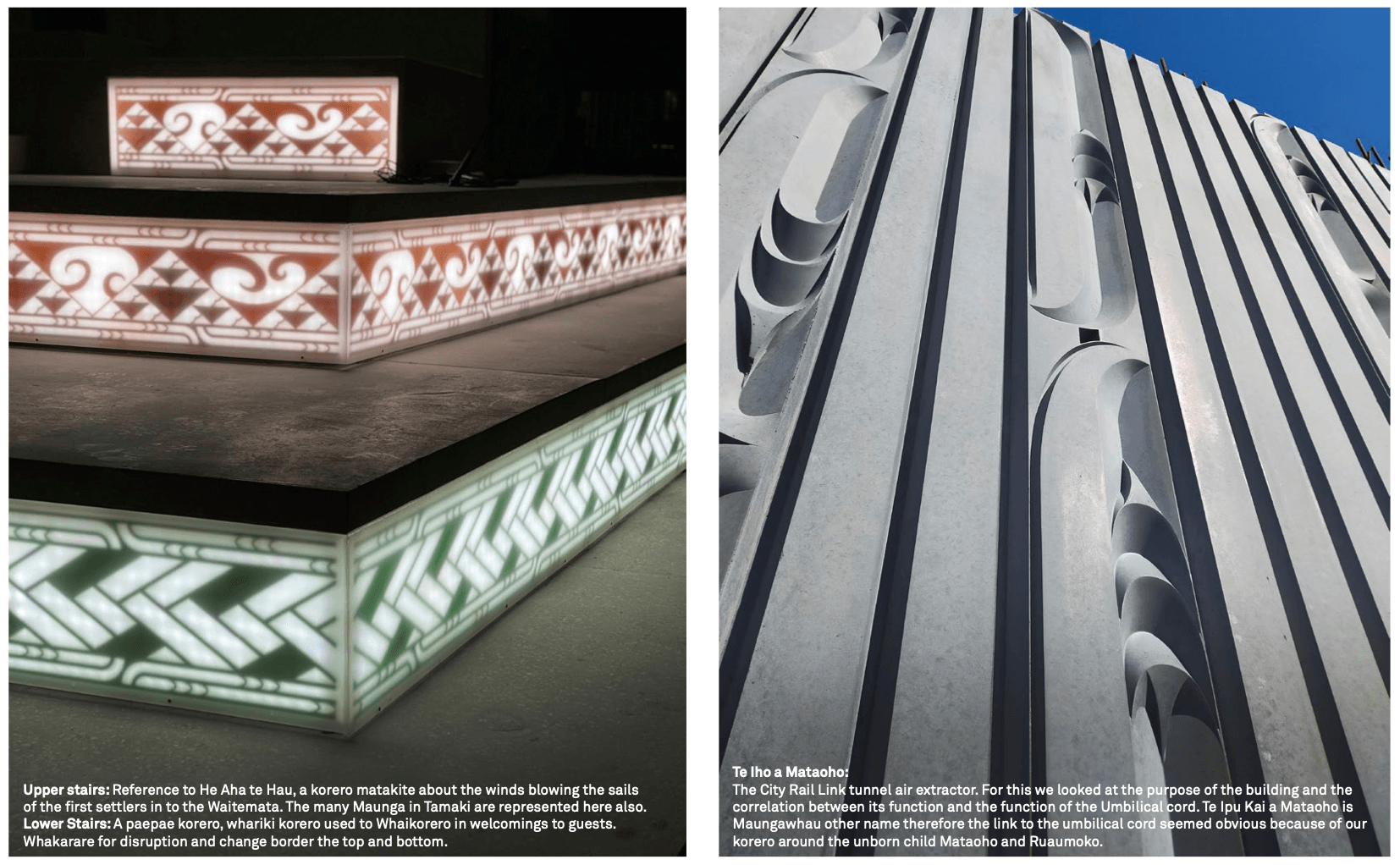
“Demand for Māori involvement in New Zealand’s built environment has grown significantly in the past decade,” says Claire Robinson, Te Tumu o Toi Toi Mai Chief Executive. That involvement can take the form of Toi Māori, strategic planning, creating ta.onga, cultural leadership and co-design. There’s a growing desire to reflect Aotearoa’s cultural identity in our built environments which is resulting in an emerging and quickly growing industry. Great, except “the value Kaihanga Toi Māori bring to projects is undervalued by the commissioning agencies.”
Robinson says that “too often they are treated as an afterthought through a koha payment and aren’t included in the procurement process or factored as a specific budget line or cost.” This part of the industry is somewhat invisible in traditional economic measures, and there’s an absence of scaffolding in terms of processes and value.
To address this issue, Toi Mai has been holding wānanga with Kaihanga Toi Māori (practitioners fluent in the visual articulation of mātauranga Māori in a creative context) for the past 18 months. Out of the kōrero has come a report released last week – He Toi Whakairo, He Mana Tangata (where there is artistic excellence, there is human dignity). The report establishes best practice guidelines for commissioning agencies working with Kaihanga Toi Māori. It covers tikanga Toi Māori (engagement), kaitiakitanga (guardianship) and utu (remuneration) with a series of recommendations and guidelines to establish industry benchmarks and standards.
Alongside the report, there’s a resource for practitioners, particularly in the early stages of their career, to help them scope and price commissioned Toi Māori works. It includes proposed remuneration rates, and prompts to understand the needs and scope of projects.
Issues of pay are the easiest to grasp. The report is particularly clear about one thing – koha is not to be used as payment, unless specifically requested. Logically the labour of Kaihanga Toi Māori should be factored into budgets at appropriate rates. Much Kaihanga Toi Māori knowledge and skills won’t neatly fit into Western tick-boxes for pay brackets, yet pay needs to be equitable and appropriate. The report uses current industry architectural remuneration rates as a benchmark and suggests the rates below.
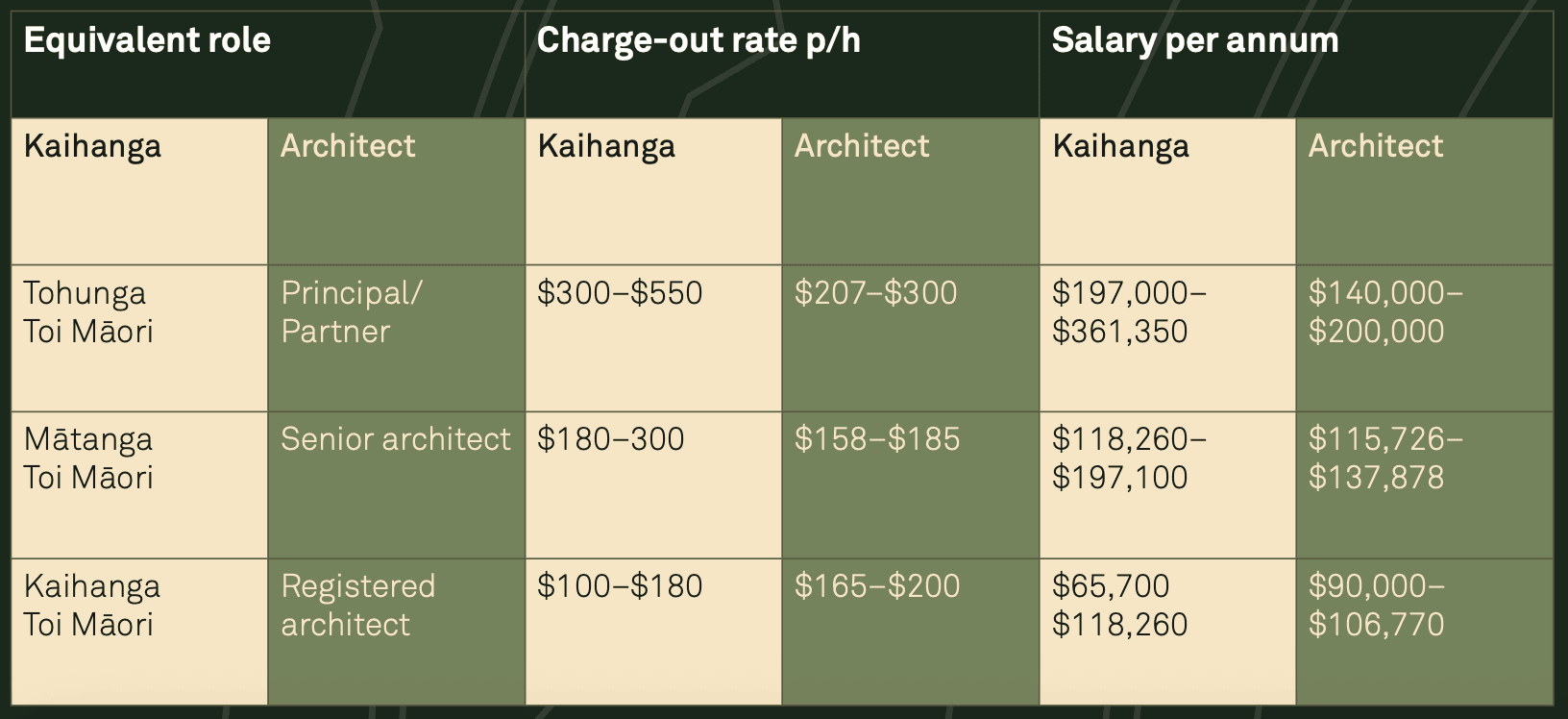
But utu is just one part of the report. Just as important are sections about cultural value, engagement and understanding. The work of Kaihanga Toi Māori is not about slapping some colour or pattern on an otherwise finished structure, but people are often unaware of the full significance of the work. The report states an aim that Ngā Toi Māori will be repositioned in an appropriate way so that it is valued and understood at a societal level. The lack of understanding is the underlying reason why Kaihanga Toi Māori are so often contacted at the finishing stages of projects to “Māori-ify” them, says the report. This is no way to go about important matters.
The guidelines for tikanga state that Kaihanga Toi Māori should be involved from the beginning of projects so that their insights can shape the vision and so that they have oversight of the project’s needs and scope. There should also be engagement between the commissioning agency, mana whenua and Kaihanga Toi Māori to establish clear partnerships of trust and understanding. Importantly, the procurement process should align with tikanga Māori, meaning that Kaihanga Toi Māori should not be put in a position where they’re competing with each other. Instead, they should be mandated by their iwi and supported by Tohunga Toi Māori.
The guidelines for kaitiakitanga highlight that guardianship is a priority, and that projects should look after taonga and Toi Māori while also maintaining relationships between people. This requires clear roles and responsibilities around maintenance, Intellectual Property, ownership, use and misuse. Fitting legal frameworks may not yet exist, so legal support should be engaged and discussions facilitated. This is the type of thing that’s knotty, complicated, and can take forever at first, but once people begin to understand all the considerations that need to be made, the process becomes clearer.
Ngataiharuru Taepa, Tohunga Toi Māori and report consultant, says there’s been some fear among practitioners around trying to define tikanga, kaitiakitanga and utu, but he believes the guidelines are necessary. “If we don’t define it, others will do it for us,” he says. “If we don’t, the next generation will have to do what we did, which is find their way through and be blown around in the wind”.
💥News on the wire
Another goodbye to an arts media platform

Contemporary HUM, a hub for Aotearoa arts abroad since 2016, announced its closure on Wednesday. The website will remain, but will not be updated, becoming an archive. A letter from the board states that since their funding decreased in 2023, “our tiny team and voluntary board has been proactive, analytical, entrepreneurial and stubbornly optimistic”. But, the last four applications for Creative New Zealand organisational funding have not been successful, and while individual giving and paid partnerships have helped, “we cannot continue to tread water”. Extremely sad news.
And goodbye to the Basement Theatre’s trapdoor
Julia Croft has descended from the trapdoor as Kate Sheppard, Priya Sami stepped down a ladder in stiletto heels while singing, and now the hole in the ceiling has been boarded up. Health and Safety guidelines have changed since the trapdoor was first punched out of the ceiling in 2011 (for Young & Hungry, says theatre veteran Sam Brooks) and so it had to be closed up. “We looked at all possible solutions to get The Trapdoor up to standard,” says Basement’s RIP post, “However, it was clear that closing it up was the safest and most cost-effective option.”

Tusiata Avia is the 2026 International Institute of Modern Letters Writer in Residence
Congratulations to the acclaimed poet, who is adding another accolade to a long list. Avia will begin the year-long residency (that comes with a stipend and office) in February and work on a new collection of poems provisionally titled How to Make a Terrorist. “I'm excited to be returning to Te-Whanganui-a-Tara Wellington and to the International Institute of Modern Letters, where my writing career really began, back in 2002,” she says. “It’s a great opportunity to create something new and contribute to the life of the university and the city.”

British Council's Connection Through Culture grant winners announced
The programme aims to support a new wave of artistic collaborations between the UK and international partners. This year, of the 127 projects awarded grants, four are from Aotearoa.
Tāmaki Paenga Hira Auckland War Memorial Museum will host a rare eighteenth-century pauku (war cloak) on a five-year research and exhibition loan from the Oriental Museum, Durham University.
CIRCUIT Artist Moving Image has been awarded a grant for a project called Ka Mua Ka Muri - Walking Backwards Into the Future which aims to connect artists from Aotearoa and Scotland to examine how contemporary moving image technologies activate ancestral knowledge, sustain connections to land and home amid displacement, and inspire new models of activism and resilience.
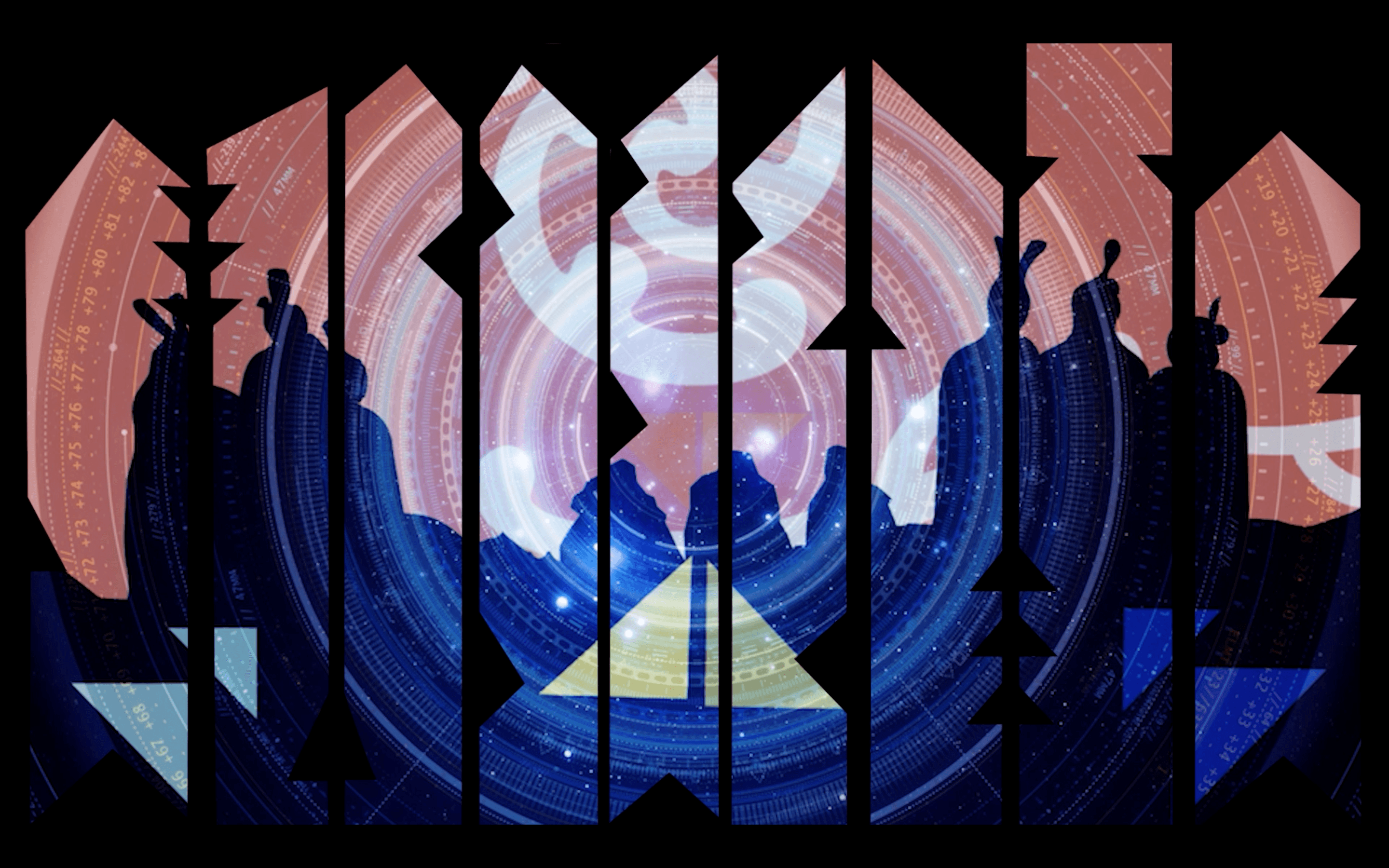
Auckland Theatre Company’s grant will go towards bringing acclaimed British playwright Simon Stephens to Aotearoa for an intensive week-long programme for over 80 New Zealand theatre practitioners in February.
UNESCO City of Design Whanganui has been awarded a grant for a residency programme connecting indigenous and ancestral textile practices between Whanganui, New Zealand and Dundee, Scotland.
New programme for early-career arts writers
Artspace Aotearoa and The Chartwell Trust have teamed up to create a programme that supports five early-career writers to produce new texts. It’s a year-long programme based in Tāmaki Makaurau and applications are open now until 21 November.
Proudly Asian Theatre’s hiatus is over
PAT took a hiatus in 2024 to develop business and revenue strategies, and have come back loud in the past few weeks with announcements. The organisation has introduced more ways for people and business to support its work, through Patreon, sponsorships and partnerships; started a directory of Asian arts folks; and has announced its first post-hiatus show: Genuine and Stable. The new play by emerging playwright Uhyoung Choi will premiere 9 December at Auckland’s Herald Theatre.

Aotearoa artists to participate in the Shanghai Biennale for the first time
On 7 November China’s most important contemporary art event, the Shanghai Biennale, will open. Among the over 250 works by 67 artists and collectives, there will be four from New Zealand. Ngahina Hohaia (Taranaki Iwi, Te Atiawa, Ngāti Ruanui, Ngāti Mutunga, Parihaka), Brett Graham (Ngāti Koroki Kahukura, Tainui) and Shannon Te Ao (Ngāti Tūwharetoa, Ngāti Wairangi, Ngāti Te Rangiita, Te Pāpaka-a-Maui) and Luke Willis Thompson (New Zealand, Fiji) are each presenting works, with support from the Office for Contemporary Art Aotearoa.
Vincent O’Malley and Rangi Mātāmua each win $60,000
The two writers have won Judith Binney Fellowships, awards that support scholarship of the kind that characterised Judith Binney’s historical writing. If it sounds kind of familiar it’s because O’Malley also won a $25,000 award just last month!
Another two writers, Mikayla Journée and Natalie Looyer, have also been awarded $20,000 each by the Judith Binney Trust to support historical research and writing projects.
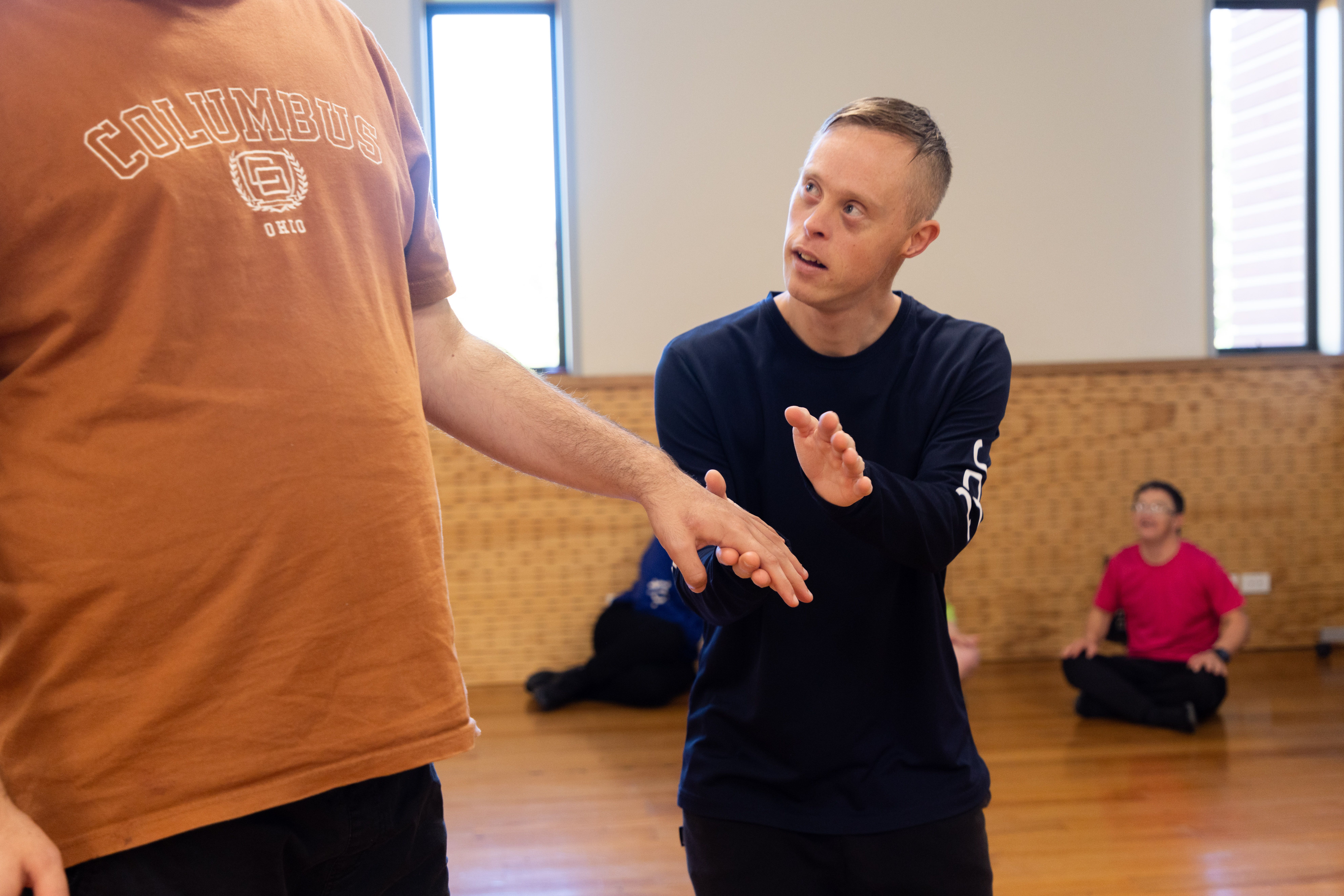
Jolt taking disability-led dance to South Korea
Jolt, pioneers of innovative, inclusive dance practice based in Christchurch, were invited by Seoul-based disability dance company Light Sound and Friends. Light Sound was inspired by Jolt’s model of disability-led dance education in Glasgow last year. They will create a collaborative new work and Jolt will lead professional development sessions focused on dance teaching and leadership. Then the Jolt crew will head to Busan to connect with the Busan Cultural Foundation, Busan Dance Company, and Ongru Creative Village and lead workshops there.
NZ indie film Notes From a Fish returning to cinemas
The screwball comedy made with $10,000 and a tiny crew sold out theatres across the country at Whānau Mārama New Zealand International Film Festival, and so is back for more screenings in Auckland, Hamilton, Wellington and Christchurch from 3 December.
Read more about how the film was made from producer Eva Trebilco on The Big Idea!
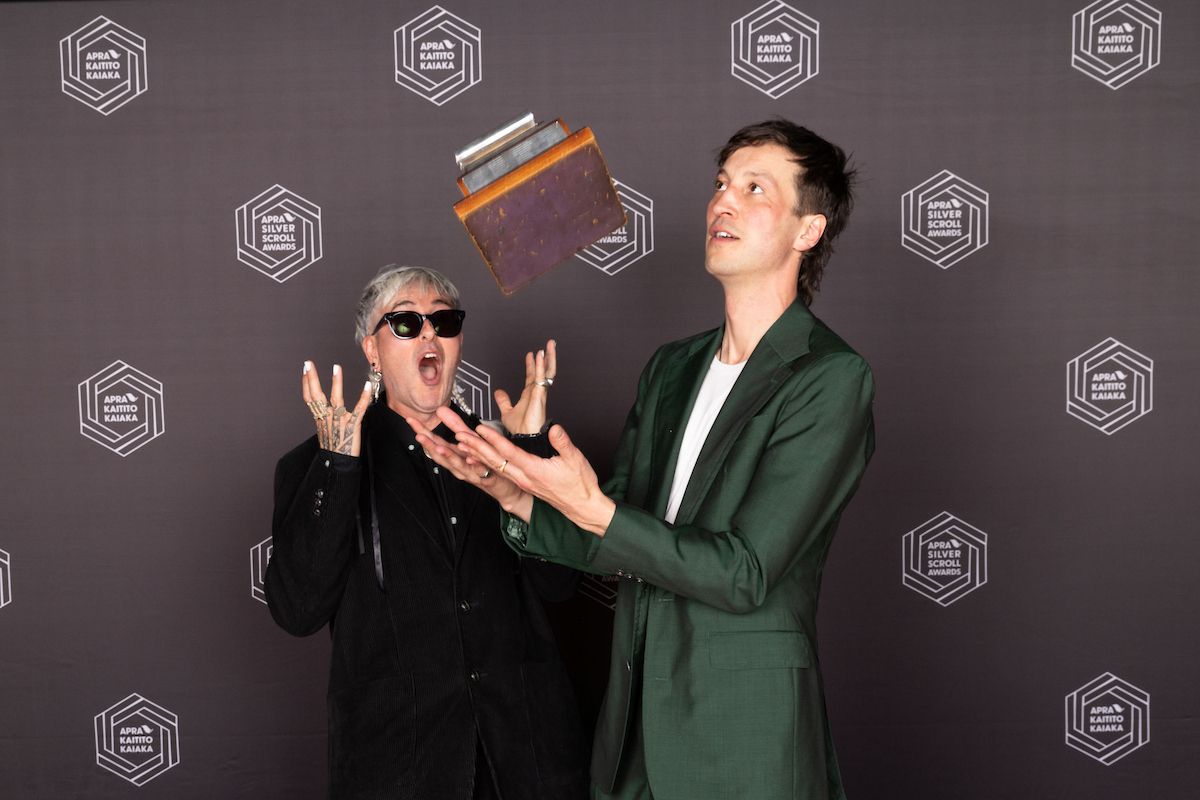
Marlon Williams and Te Pononga Tamati-Elliffe (KOMMI) win the APRA Silver Scroll
The pair won the 2025 Silver Scroll Award | Kaitito Kaiaka for Aua Atu Rā – a song inspired by ‘60s Māori showbands and laments isolation, while finding comfort in shrugging shoulders and saying “Kāore he aha nei” (it doesn't matter). Other categories below:
APRA Maioha Award | Tohu Maioha: Kei Whati Te Marama written by Henare Kaa, Tim Driver, Hemi Hoskins and Rory Matao Noble, performed by Dillastrate
SOUNZ Contemporary Award | Te Tohu Auaha: of coral and foam by Ihlara McIndoe
APRA Best Original Music In A Series Award | Tohu Paerangi: Mahuia Bridgman-Cooper for The Gone Season 2
APRA Best Original Music In A Film Award | Tohu Pūmanawa: Arli Liberman and Tiki Taane for Ka Whawhai Tonu – Struggle Without End
NZ Music Hall of Fame | Te Whare Taonga Puoro o Aotearoa inductee: The Warratahs
👀 Further reading and watching
Arts therapist and artist Virginia Frankovich explains why it's always good to go too far, and how she fell off a stage in a Shameless Plug.
Penman House, where Robin Hyde once wrote in the attic, is under threat of demolition. Salene Schloffel-Armstrong spoke to Paula Morris who is leading the charge to save the piece of literary history.
National Youth Drama School artistic director Ben Fagan dives into three decades of VHS archives, and asks the familiar faces (politicians, actors, etc) whether an education in performing arts has been useful.
Colourful and kaleidoscopic, the brainchild of Joshua Worthington-Church, Exploding Rainbow Orchestra, brings together nearly 50 musicians to perform pseudo-orchestral arrangements of new music from Aotearoa. We asked Rachel Ashby to explain the audacious project.
Learn a bit more about Tāme Iti (Ngāi Tūhoe) – once a quiet person – over on RNZ.
Recently returned from Ecole Philippe Gaulier, Sean Burnett Dugdale-Martin shares his personal motto, most embarrassing career moment, and details about his commute in a Shameless Plug.
Read this year’s winning Landfall essay, Four Hours in the Dark, Forgetting by Tasmin Prichard.
Tongan-born artist Kulimoe’anga Stone Maka’s new work at the Gus Fisher Gallery revives ngatu tā‘uli, black tapa, a form of tapa cloth traditionally reserved for Tongan royalty.
📧 Say hi!
Wow you made it all the way to the end!
How did you find it? Let me know: editor@thebigidea.co.nz